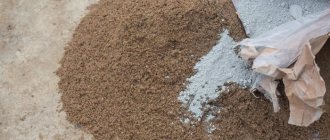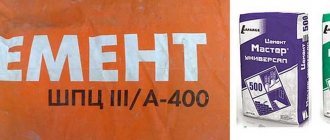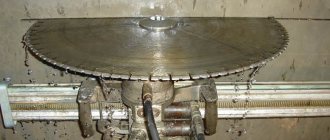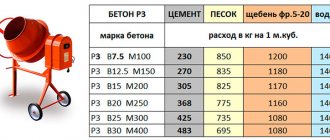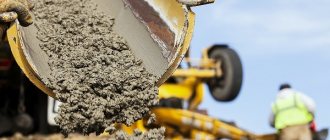The foundation mortar uses hand-made sand, crushed stone, water, cement powder, plasticizers and other stabilizing additives. Portland cement, Portland slag cement, quick-hardening cement, etc. are in demand in construction. When determining the proportions of concrete, soil characteristics, load levels, structure, base materials and building regulations are taken into account.
Types of concrete for foundations
The following types of concrete for foundations are in demand:
- Portland cement refers to hydraulic binders that are produced by mixing gypsum, cement clinker, calcium silicates and additional components. Construction mixture is in demand at different stages of construction. It is based on silicates (belite and alit). Portland cement is produced as hydrophobic, fast-hardening, plasticized, road cement, with moderate exotherm, normal-hardening, sulfate-resistant, standard white or colored. The material is used when pouring a monolithic foundation.
- Portland slag cement is frost-resistant and resistant to high humidity; the mixture hardens at an average rate. Cement contains: gypsum, blast furnace slag, clinker materials, mineral components with the permitted amount of magnesium up to 6%. The elements are mixed and dried to a moisture level of 1%, then ground to a powder state.
- Pozzolanic Portland cement is used for underground structures and is moisture resistant. The cement mortar material is not suitable for external elements because... may shrink. The mixture is characterized by greater density, viscosity, and water permeability. The composition includes plasticizers to reduce the mobility of the base.
- The fast-hardening cement mixture is suitable for professional builders because... hardens in the shortest possible time. The convenience of the material lies in its high strength. You can prepare a cement mortar of this brand if you need to carry out work in a short period.
The decision which cement is best to use in construction work is determined by climatic conditions, seasonality, humidity level, and load on the base.
Setting Features
The first phase is setting. This process, during which the flowable concrete composition gradually turns into a solid phase, begins immediately after pouring into the formwork or trench. The solution thickens when cement interacts with water and fillers.
At the initial stage, there are weak bonds between the components of the mixture, which can easily be broken under the influence of forces, after which it is impossible for the composition to re-set. The setting period requires special care with concrete, which must not be touched as this may damage the structure.
At the “liquid” stage of the setting process, topping up can be done, since the internal structure of the mixture remains constant. The setting time is determined by the ambient temperature. The duration of the “liquid” phase decreases with increasing street temperature.
The minimum duration of the first phase is 3 hours at an ambient temperature of at least 15 degrees Celsius. The worst setting occurs at subzero temperatures. In this case, the time interval until the end of the first stage is 24 hours.
Components for concrete
Before making cement mortar for the foundation, you will need to prepare the following materials:
- main substance;
- river sand;
- crushed stone;
- water;
- additional components (plasticizers, stabilizers).
The liquid for filling must be purified, without clay and chemical components (gasoline, machine oil, fuel oil, etc.). It is optimal to use running water.
Sand is selected without impurities, silt and clay inclusions (the permissible percentage of suspended matter is 5%). Fatty components can form a film, which will reduce the quality of bonding. The size of sand particles should be 1.2-3.5 mm. The grains are sifted, washed and dried.
The cement is selected of high quality (grades M200-500). The technical parameters of the building material must correspond to the operating conditions of the building, the dimensions of the foundation, climatic conditions, etc. Fracture strength and compressive load bearing are important.
Crushed stone is selected for the construction mixture. Limestone material and gravel are not suitable as filler. Crushed stone enhances the strength of the composition. Its optimal size is 1-8 cm. Less durable additives are made of expanded clay and gravel. A mixture without crushed stone for the manufacture of a foundation base is prepared during block construction of a structure or for the rapid pouring of pile supports.
Additional components are required to create a solution for different conditions (frosting weather, heat, high humidity, high loads, exposure to aggressive chemical compounds). When adding components, proportions must be observed.
The following additional substances are in demand:
- anti-frost;
- strength-increasing fiber;
- plasticizers;
- coarse filler.
Let's take care of formwork and reinforcement
For formwork you can use various materials: boards, plywood, tin and others. The main thing is that the material is strong enough and even, it will have to be given its final shape. If you prefer a buried foundation, the formwork will have to be done directly in the trench. Otherwise, the formwork should be installed in a trench, but at the same time rise 40-50 centimeters above the ground.
When the formwork is ready, it’s time to take up the reinforcement. From it you need to build a frame, shaped like the future foundation. This is quite easy to do. It is enough to tie the reinforcement with thin, flexible wire or, even better, weld it. The finished frame is lowered into the trench and installed there securely.
Concrete grades for foundations of low-rise buildings
When selecting a type of concrete, the geological parameters of the area and the characteristics of the building are taken into account:
- relief of the site;
- force of pressure on the base;
- climatic conditions;
- soil freezing depth;
- design features of the base;
- presence of a basement;
- characteristics of basements;
- building height;
- ground water level;
- weight overload;
- project budget.
When deciding what kind of cement is needed for the foundation when constructing low buildings, the indicators of the following compositions are taken into account:
- M100;
- M150;
- M200;
- M250;
- M300;
- M350, etc.
M100 refers to light mixtures, the density of the material reaches 2370-2400 kg/m³, the strength is class B7.5 (98 kg/cm²), the water resistance parameter is W2-W4, the mobility of the base is about P2-P4, the frost resistance of the mixture is categories F50-F100 , hardness - Zh2-Zh4. Water resistance and frost resistance characteristics may vary depending on the plasticizers added.
The material is slightly resistant to loads, suitable for private buildings, when pouring foundations, as a concrete pad, for decorating driveways, building cellars and sheds.
Concrete grade M100 is divided into several subtypes based on specific gravity:
- lightweight - withstands loads of 500-1800 kg, contains porous fillers (expanded clay particles, tuff, shell rock) or foaming components;
- heavy - withstands weight up to 1800-2300 kg, filled with gravel or crushed stone;
- especially heavy - designed for loads up to 3000 kg, the formula contains metal particles.
M150 is a lightweight mixture that can be used for small-sized one-story buildings made of cinder blocks, aerated concrete blocks or shell rock. The strength of the material is average. Density is 2200 kg/m³. The frost resistance level of the composition is F50. The grade of concrete is suitable for the construction of outbuildings and garages.
Waterproof rating - W2. The level of water absorption is high, so at the pouring stage it is necessary to make a waterproofing layer in places with the highest humidity. The material hardens quickly, ensuring high speed of construction work. The mixture is not used in aggressive environments to prevent destruction of the base.
M200-M250 are universal compositions for low-rise buildings (1-2 floors) with light floors. The buildings can be frame, panel or made of wooden beams.
The level of compressive strength of concrete grade 200 is 150 kgf/cm², the frost resistance index is F100 (100 freezing cycles), and the water resistance characteristic is W4.
The advantages of the composition are its versatility, low cost, and wide scope of application in construction work. The material is used for ceilings, lintels, and is combined with different types of metal reinforcement. It is suitable for building structures without heavy loads and without high humidity conditions.
M300 is used for low-rise buildings made of expanded clay, cellular or aerated concrete blocks. The composition is recommended for the construction of foundations of private houses, stairs, outbuildings, wall panels, monolithic foundations, platforms. The material is suitable for professional and independent work.
Several types of aggregates are used for the concrete grade (granite, gravel or limestone).
M350 is suitable for low brick buildings or pouring the base for walls made of monolithic concrete. The material belongs to high-quality concrete compositions, used for the construction of buildings with high mechanical loads, operating in climatic conditions with temperature changes.
The composition provides a base with high compressive strength. Concrete powder is combined with fine-grained, coarse-grained or medium-grained sand. The high strength of the material allows it to be chosen for maximum loads. The composition can withstand changes in temperature conditions and mechanical stress. The advantage of the building mixture is its high resistance to compression.
M400 is durable and frost-resistant. The construction mixture contains cement, crushed stone, purified sand, water and plasticizers. The material is optimal for bridge structures, buildings with heavy loads on the foundation, for road surfaces, preparation of arched openings, storage facilities, and stairs.
The composition is used to create dams, facilities in the energy, engineering, and mining industries, and for the construction of collectors for communication systems. The grade of concrete is suitable for buildings that are located near railway lines, highways, metro stations, etc.
M500 is a grade of building material characterized by high compressive strength (500 kgf/cm²), bending resistance is 5.9-6.4 MPa. The material has excellent frost resistance and water resistance. The composition dries in 1-10 hours. The density of the construction mixture is 1100-1600 kg/m³, the actual density is 3000-3200 kg/m³.
However, it is necessary to take into account the low sulfate resistance of the brand; the material is not suitable for soil with a high level of mineral water.
The building mixture is recommended for creating structures that require strength and can withstand increased loads. The high hardening speed allows the concrete grade to be used for emergency and restoration work.
Recommendations for self-filling
To make concrete, use a concrete mixer, a wooden box, an iron bath or wood flooring. It is important to ensure that no debris or other impurities get into the solution. To begin with, pour in the dry ingredients - sand, crushed stone, cement, mix them thoroughly to obtain a homogeneous composition. Then slowly add water, stirring until evenly moistened. And only after that they start pouring.
Photo: prepared solution
Keep in mind that cement does not store for long; over time, its grade decreases under the influence of moisture. After the first month, about 10% of strength is lost, after 3 – 20%, in six months this figure reaches 30-40%.
When pouring a foundation, the most popular unit of measurement is a bucket, so few people accurately observe the correct proportions. It is not recommended to stir the mixture with a shovel, as the concrete will be inhomogeneous. Thus, losses may occur and eventually the M 100 grade will be released. But this will be enough to build a small house or gazebo.
Even if you deviate greatly from the standards for pouring a foundation, it will still be durable and will withstand heavy loads, so it will be suitable for building a house. But, according to official standards, you should take cement M 300 or M 400 to get a grade of 200 or more.
Pour the foundation in warm weather; negative temperatures provoke some difficulties. For example, you will have to heat the water and the composition itself, since they may freeze before hardening begins. And when hardening begins, without heating the concrete will begin to freeze due to the water contained in it, and the resulting ice crystals will begin to destroy the foundation from the inside.
If you follow the proportions and prepare the composition according to the standards, even at home the solution will be homogeneous and as close as possible to the correct version, so do not worry about its strength.
Now you know what ratio of components is needed to prepare 1 cube of concrete. The main thing is to accurately calculate the proportions and try to follow the technology. Concrete is an easy-to-prepare composition, so the knowledge gained will help even a novice builder to easily build a foundation for a house or gazebo.
Proportions for the foundation
The optimal ratio of sand and cement for the foundation is 1:3 or 1:2. The 1:3 ratio is universal and suitable for the foundations of buildings erected on unstable soil. Crushed stone is used for the composition in a ratio corresponding to the amount of sand in the solution.
The percentage of water is selected experimentally, because The volume of liquid is affected by the level of sand humidity and air temperature. The consistency should be similar to sour cream. To improve the plasticity of the composition, plasticizers are introduced.
From cement m400
When deciding how to calculate how much M400 cement is needed, we are guided by the following data:
| Concrete grade | Proportions of components: C:P:SH:V, kg | Cement M400 per 1 m³ of solution, kg | Sand | Crushed stone | Water |
| M150 | 1:3,5:5,2:0,9 | 215 | 735 | 1140 | 190 |
| M200 | 1:3:4,5:0,7 | 255 | 715 | 1125 | 190 |
| M300 | 1:2:3,3:0,6 | 338 | 670 | 1105 | 190 |
From cement m500
When determining what ratio of cement 500 and other components is required for construction work, take into account the following information:
| Type of concrete | Proportions of components: C:P:SH:V, kg | Cement M500 per 1 m³ of solution, kg | Sand | Crushed stone | Water |
| M150 | 1:4:6:1 | 190 | 755 | 1140 | 190 |
| M200 | 1:3,3:5:0,8 | 225 | 738 | 1125 | 190 |
| M300 | 1:2,5:3,5:0,7 | 290 | 705 | 1105 | 190 |
Calculation example
To determine the proportions of cement and sand for the foundation, it is necessary to take into account the characteristics of the building mixture. For 1 m³ you will need the following volume of cement:
- M100 - about 220 kg;
- M200 - about 280 kg;
- M250 - up to 330 kg;
- M300 - about 380 kg.
For accurate calculations, you should calculate the dimensions of the base. For 1 part cement you will need 3 parts sand and 5 parts gravel. Accordingly, for 50 kg of powder, 150 kg of sand and 250 kg of crushed stone are taken. The composition includes water to create a solution of medium consistency. For large volumes of construction work, proportions can be calculated in buckets.
Preparation of cement mortar for plaster
To perform high-quality plastering of surfaces, grade 400 cement is required. Take one part of the dry base, 5 parts of sand, and lime mortar. The use of these components allows you to dilute the cement as needed. The proportions may vary slightly if old cement is present. In this case, a little more material will be required.
If you need to plaster a small area, the cement mixture can be mixed by hand, using any convenient container. However, it is much more convenient to mix in a concrete mixer. The finished solution should have such a consistency that it slides smoothly off the trowel when tilted.
Cooking methods
When choosing what proportions of cement, crushed stone and sand are needed for the foundation, take into account the method of manufacturing the composition:
- mechanical (using a concrete mixer powered by electricity);
- manual.
Mechanical method
Before mixing cement and sand into a fastening composition for large-scale construction using a mechanical method, it is necessary to ensure the availability of the following equipment:
- concrete mixer;
- buckets;
- water container;
- hoses;
- shovels;
- extension.
It is optimal to measure the ratio of building materials using buckets. The concrete mixer is selected depending on the area of the building’s base and other structures. When deciding how to dilute cement for the foundation, the dimensions of the said device are taken into account; standard dimensions are 50-300 liters.
To build a private cottage, you will need a 220 V concrete mixer; large-scale projects require high power (3-phase 380 V apparatus). Electricity is connected using an extension cord.
The components, according to the standard proportions of sand, concrete, stabilizers, and water, are mixed in the selected device. The mass should be homogeneous, the consistency of sour cream.
Manual method
For the manual method of producing the composition, the following tools and equipment are used:
- mixing container;
- metal buckets;
- water barrel, hose;
- shovels (bayonet and shovel);
- textile.
Water with additional components (stabilizers, plasticizers) is poured into the container, sand and cement powder are poured. Using a bayonet shovel and a paddle, stir the solution until it reaches a homogeneous creamy consistency. Then crushed gravel is included in the composition and the mixture is brought to a state of readiness.
How to clean cement from brick or tile
There are several ways to clean bricks or tiles from cement mixture residues:
Mechanical cleaning
- You can treat the surface of the bricks with sandpaper or a grinding machine.
- To clean bricks, especially silicate bricks, it is better not to use solvents, but to clean them by rubbing against each other.
- If there are large marks, they are removed with a grinder and a diamond wheel. She needs to work very carefully so as not to leave deep cuts.




